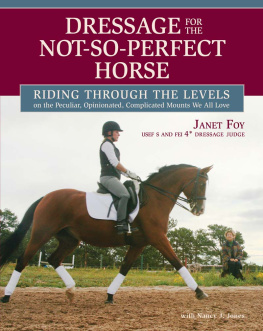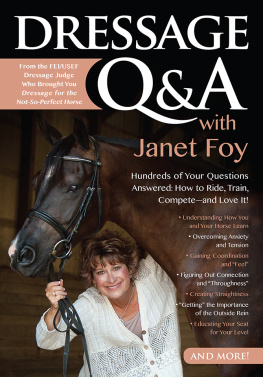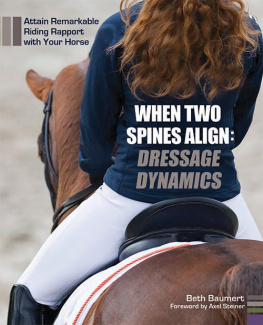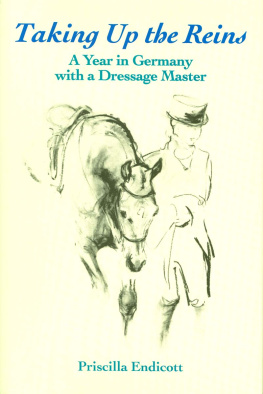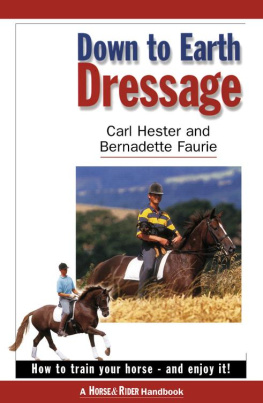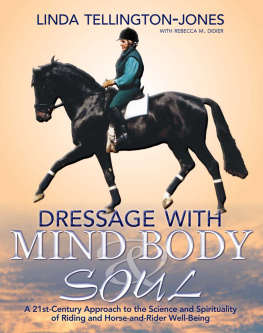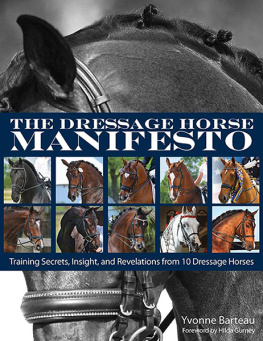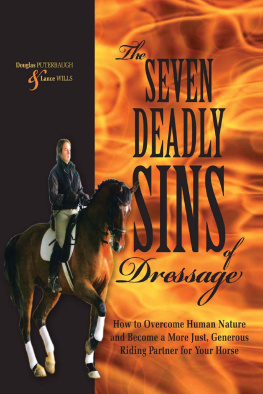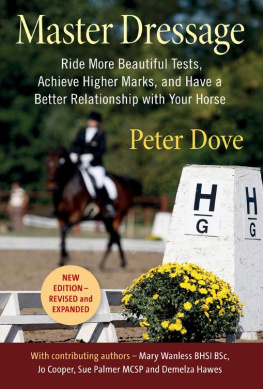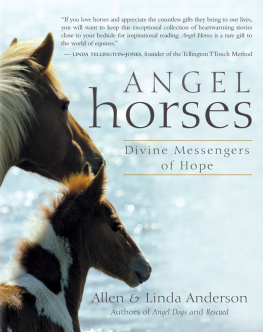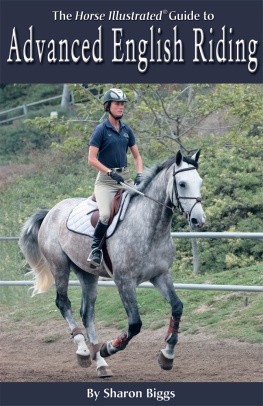
First published in 2012 by
Trafalgar Square Books
North Pomfret, Vermont 05053
Printed in China
Copyright 2012 Janet Foy with Nancy J. Jones
All rights reserved. No part of this book may be reproduced, by any means, without written permission of the publisher, except by a reviewer quoting brief excerpts for a review in a magazine, newspaper, or website.
Disclaimer of Liability
The authors and publisher shall have neither liability nor responsibility to any person or entity with respect to any loss or damage caused or alleged to be caused directly or indirectly by the information contained in this book. While the book is as accurate as the authors can make it, there may be errors, omissions, and inaccuracies.
Trafalgar Square Books encourages the use of approved safety helmets in all equestrian sports.
Library of Congress Cataloging-in-Publication Data
Foy, Janet.
Dressage for the (not so) perfect horse : training secrets for the peculiar, opinionated, nonconformist, complicated mounts we all ride and love / Janet Foy with Nancy J. Jones.
p. cm.
Includes index.
ISBN 978-1-57076-509-4
1. Dressage. 2. Horsemanship. I. Jones, Nancy J. II. Title.
SF309.5.F66 2012
798.23--dc23
2012002722
Book design by Lauryl Eddlemon
Cover design by RM Didier
Typefaces: Myriad, Eagle
10 9 8 7 6 5 4 3 2 1
Dedication
To my family:my grandfather John Altrichter Sr, my parents John and Betty Altrichter, and my wonderful husband Michael Foy, who wanted me to write a book long before the vision took shape!
Contents
Introduction
Rodeo Queen to Dressage Queen
Quick Reference
Imperfections and Evasions
Afterword
Meet My Horses
INTRODUCTION
Rodeo Queen to Dressage Queen
First Lessons, First Horses
I grew up in Colorado Springs living next to a horse pasture so my sister and I naturally fell in love with horses. My Austrian grandfather, John Altrichter Sr., or Papa (my maiden name, Altrichter, means old judge in Germana sign perhaps?), was a true animal lover, and he made sure my sister Charlene and I got plenty of exposure to horses.
On Saturdays, Papa would take us to Mark Reyners stables in Austin Bluffs (an area of Colorado Springs) where we would have a group Western riding lesson. Afterward we always lunched at Conways Red Top, where the burgers were the size of soup plates.
Soon my sister and I convinced my mom and dad we must have a horse. Now up to this point, my sister and I were supplementing our Saturday lessons by going into the pasture next door with our jump ropes, putting them over a horses neck, jumping on, and riding away. There was not much chance of being caught by the neighbors as the pasture was about 400 acres with hills, trees, and streams!
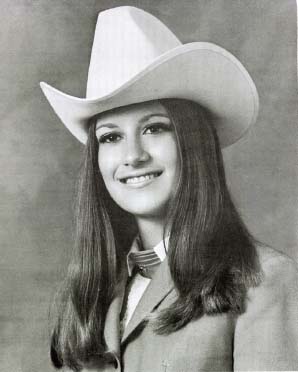
Janet Altrichter, Girl of the West, 1971.
One of the horses in the neighbors pasture was a little black Quarter Horse called Snakes who was for sale for $500. My sister and I had both secretly ridden him so we already loved him. However, once we were his owners, Snakes would not let us catch him. Now, instead of just jump ropes, we had to carry a halter and a bucket of grain. Snakes would put his head in the bucket, grab a mouthful of grain, and then spin and run away. (When we later sold him we had to hire a cowboy to chase him all over the pasture and rope him.)
Being sisters, we soon were fighting over Snakes. So Mom bought a pony, Cricket, for my little sister. He was a typical naughty pony. My friends and I enjoyed taking her and Cricket into the trees where to our delight he would find just the right height tree branch to knock her off.
Cricket the pony did not last long, especially when he dragged my Green Beret uncle through the garden. Chief, a very tall, kindly older Appaloosa became my sisters new mount.
About this time I started to do local gymkhanas, riding to and from the shows. Snakes did well and, of course, then I wanted to attend some larger shows, but we did not have a horse trailer. Next purchasea horse trailer.
Mom and Dad would hook up the trailer behind the Oldsmobile Delta 88 and off we would go. The next problem was that Snakes was not good enough to do well at the bigger shows. So another purchasea new horse.
We bought a blue roan Appaloosa named Popeyed Chief. Pepper and I had a great life together. We rode in the all-girls drill team, the Pikes Peak Rangerettes, whose highlight was always the performance at the National Western Stock Show in Denver.

My grandfather, John Altrichter Sr. (Papa), who instilled in me his love of animals and nature.
I tried barrel racing him, but it made him crazy, so I ended up taking a lot of reining lessons and won quite a bit as a junior on the Appy Circuit. I still love reining and think the challenge of the sport set me up later to be a success in dressage.
The highlight of our career was for me to be chosen as Girl of the West for the Pikes Peak or Bust Rodeo in 1971. My two aides and I were the main promoters for the rodeo. We gave many speeches at Service Club breakfasts, lunches, and dinners. We also traveled to other rodeos within a four-state area, including Cheyenne Frontier Days. We appeared in parades and Grand Entries, and were featured in many print and television interviews, as well.
Pepper loved parades and galloping into the arena with me waving like mad at the crowds. He knew exactly where to stop and rollback. Then he would stand like a statue for the National Anthem.
College and England
Pepper was sold and retired to a great couple who owned a large ranch in Southern Colorado. I was horseless for the first time in 15 years. But college and growing up were ahead of me, and my parents could not afford to put me through college and pay for a horse.
I attended the University of Colorado in Boulder and quickly joined the CU Riding Club. I rode once a week with a hunter/jumper trainer, Colonel Nance. I have to say, I never really enjoyed this discipline, so I did not rejoin after my freshman year. I did not ride again for four years.
Then fate intervened. I married Ken Brown, and we moved to Oxford in England, where he was a Rhodes Scholar. Of course, I joined the Oxford Riding Club. I met another Rhodes Scholar wife named Virginia who was from Georgia and had been a hunter rider. We rode in the group lessons for about a month but were hungry for more. Virginia had a car, so off we went to the Talland School of Equitation in Cirencester for semiprivate lessons.
After a few months, we still had no idea what the instructor really meant, and he did not seem to want to enlighten us. So we bought a book, Lockie Richards Dressage: Begin the Right Way, which had pictures to show us what we were supposed to be doing.
I did stay at Talland and passed my British Horse Society Assistant Instructor exams. We had to show jump, go cross-country, and ride a dressage test in order to achieve this. I also learned a lot about stable management and teaching techniques. But as far as true dressage riding, I was still in the dark.
Next page
